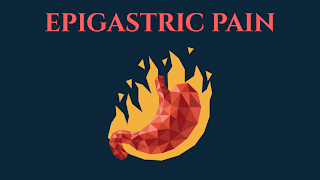EPIGASTRIC PAIN: Causes, Diagnosis and Treatment
Introduction
It is the pain or discomfort in your upper abdomen or epigastric region. It is also known as Dyspepsia.
Causes
The most common etiology of epigastric pain or discomfort has never been identified, hence it is referred to as nonulcer dyspepsia.
Epigastric pain can be manifested by the following conditions:
- Pancreatitis
- Ulcer disease
- Gastro-esophyageal Reflux Disease
- Gastritis
- Gastric cancer
- Gallstones
- Hepatic disease (hepatitis, metastases)
- Drugs; Iron and potassium supplements, Non-steroidal anti-inflammatory drugs (NSAIDs), Digoxin and Glucocorticoids
Treatment
If a person suffers from epigastric pain without undergoing the alarming features, treat him/her with- H2-Histamine Blockers (cimetidine, famotidine, nizatidine and ranitidine)
- Liquid antacid
- Proton pump inhibitors/PPIs (omeprazole, lansoprazole, pantoprazole, rabeprazole, esomeprazole, dexlansoprazole)
What are the alarming feature?
Alarming features are signs or symptoms occurring with epigastric pain or discomfort.
Alarming features include;
- Age >45
- Anemia (hemoglobin in males below 14 while in females it is below 12)
- Dysphagia (difficulty in swallowing)
- Odynophagia (pain in swallowing)
- Vomiting
- Weight loss
- Family history of gastrointestinal tract malignancy
- Gastric surgery
- Abdominal mass
Diagnosis
Epigastric pain in a person of any age associated with one of the alarming features requires Endoscopy to evaluate the underlying disease.
Epigastric pain only, in a person >45 age without alarming features requires endoscopy immediately.
Endoscopy is also recommended when just epigastric pain is not resolved by H2 blockers, liquid antacid, or PPIs.
Have a great and healthy life ahead



Comments
Post a Comment